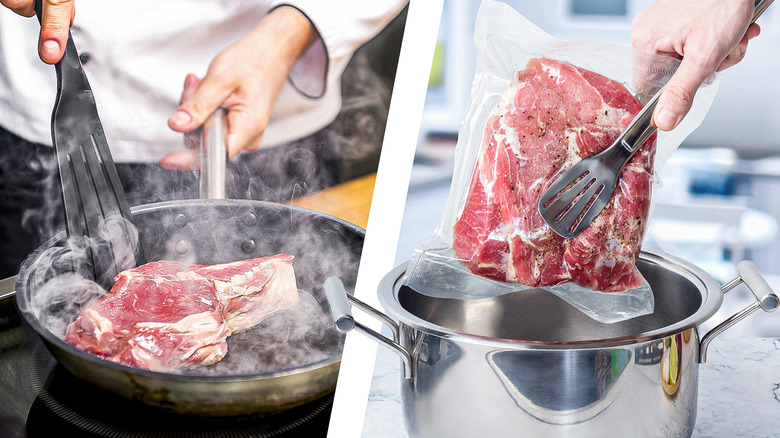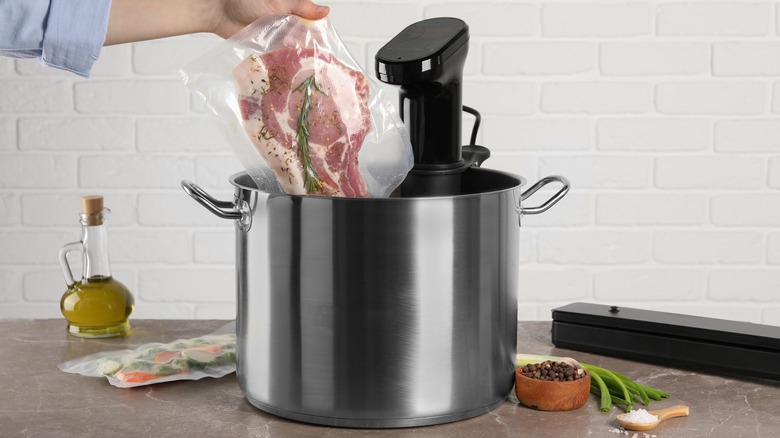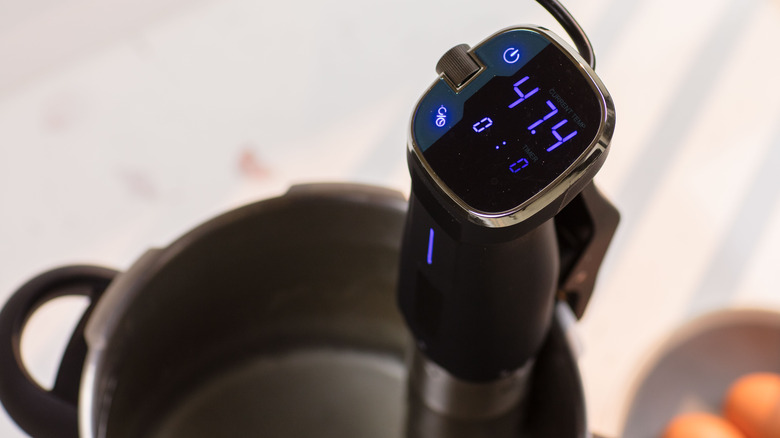Steaming Steak Vs Sous Vide: How Do These Cooking Methods Differ?
Steak remains a popular choice for home chefs, but this hearty dinner staple can become rote if all you ever do is stick it in a frying pan. There are other ways to prepare steak that every good chef should know about, if only to stay on top of the game. Two methods of cooking steak that don't receive as much attention are steaming and sous vide. Most people avoid branching out into new cooking methods because they're afraid they're going to make one of the common mistakes that happen with steak. But innovation is the name of the game, and you could miss out on your new favorite method of cooking if you never bother to give it a try.
Sous vide and steaming do share some similarities, mostly in that both of them use hot water to help cook the steak. But for all that they have in common, they are also quite different. If we were going to directly compare them, we would have to admit that sous vide is almost certainly a better cooking method for steak than steaming because it allows for greater control over temperature. Steaming is an easy and often underutilized cooking technique, but sous vide is a great way to make a variety of dinners and it really shines, here. But we're getting ahead of ourselves.
What is sous vide steak?
Most people are familiar with the name sous vide, but not everyone understands what exactly sous vide is. In a nutshell, sous vide uses sealed bags to submerge food in a temperature controlled water bath. The machine looks something like an immersion blender that hangs onto the edge of the pot of water, and it maintains a precise temperature range while circulating the water to keep a consistent temperature throughout.
The idea strikes some people as odd simply because of how different it is from more traditional methods of cooking, but sous vide is actually a great way to cook steak. The major benefit is just how precise you can get with your cooking temperature, allowing you to achieve proper internal temperatures for food safety without much risk of overcooking it. You can even sous vide frozen steak if you forgot to take it out of the freezer the night before.
But as with all things, the benefits do come with some drawbacks. Most notably, sous vide steak does not achieve a proper sear the way a steak that's grilled or cooked on the stove does. This is a problem for steamed steak as well, but there is a quick fix. Most people who enjoy sous vide steak will simply give the steak a quick sear in the pan once it's done cooking.
What is steamed steak?
Steaming makes use of hot water vapor (i.e. steam) to cook food. It's a popular way to cook carrots, broccoli, and other vegetables, though that's far from its only use. There are mistakes people should avoid when steaming food, but the process is relatively straightforward. There are two main ways people typically steam various ingredients: by boiling water on the stove and placing the food in a steam basket above the water, and by using a combination oven. Between the two, a combination oven is a better option for steaming steak because you have more control. But we'll come back to this aspect in a second.
If you're using a steam basket on the stove, the steak will simply go into the basket with a closed lid on top. Cooking time will vary depending on how big your steak is, but there is a very real risk of overcooking the steak this way. A combination oven (also referred to as a combi oven for short) mixes the technology of a convection oven together with the power of steam to produce a truly unique form of cooking that has been quite popular in commercial kitchens, but has yet to fully break through into the consumer market — possibly due to how expensive the machinery remains.
Sous vide offers more control and a greater temperature range
Steaming steak simply can't compete with how precise a sous vide machine can get when it comes to temperature. That temperature control translates to a much better steak because you can adjust it to exactly how well done you want the steak to be. For rare steak, you can set the sous vide machine to around 120 degrees Fahrenheit. If you prefer your steak well done, you can set it to around 156 degrees Fahrenheit – or even higher if you want.
This is not the case with steaming. Water boils at 212 degrees Fahrenheit, which means all steam has a temperature of 212 degrees. That's substantially higher than the 156 degrees you would set the sous vide machine to if you wanted your steak to be cooked well done. That's going to lead to some very chewy steak, as the chances of you overcooking the meat are significant. You can still make good use of overcooked steak, but it shouldn't be your goal to do so.
Combination ovens are different because they use standard temperature controls similar to a convection oven, but also have humidity control. This gives you the benefits of cooking with moisture without the drawback of being so limited in your temperature range. It's worth remembering that combination ovens are still fairly uncommon in the public sphere, though. This means that sous vide steak will almost always blow steamed steak out of the water.



